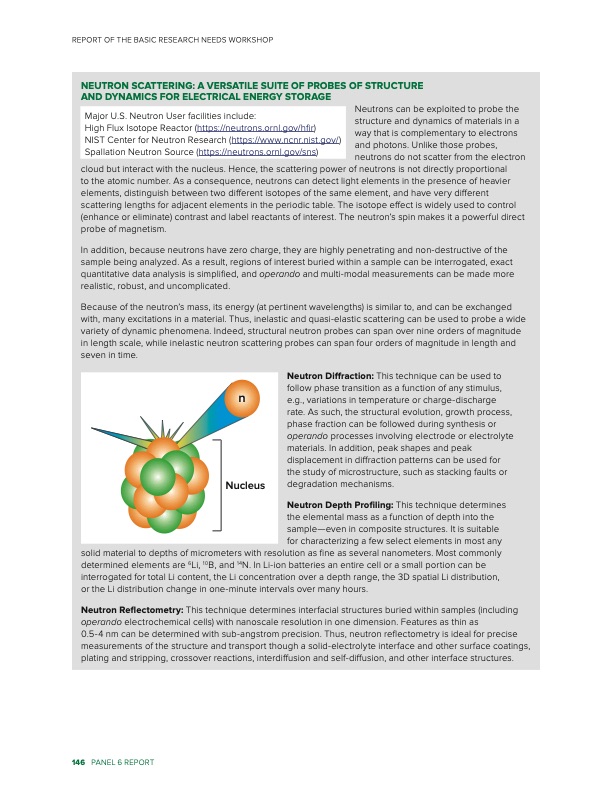
PDF Publication Title:
Text from PDF Page: 152
REPORT OF THE BASIC RESEARCH NEEDS WORKSHOP NEUTRON SCATTERING: A VERSATILE SUITE OF PROBES OF STRUCTURE AND DYNAMICS FOR ELECTRICAL ENERGY STORAGE Neutrons can be exploited to probe the structure and dynamics of materials in a way that is complementary to electrons and photons. Unlike those probes, neutrons do not scatter from the electron cloud but interact with the nucleus. Hence, the scattering power of neutrons is not directly proportional to the atomic number. As a consequence, neutrons can detect light elements in the presence of heavier elements, distinguish between two different isotopes of the same element, and have very different scattering lengths for adjacent elements in the periodic table. The isotope effect is widely used to control (enhance or eliminate) contrast and label reactants of interest. The neutron’s spin makes it a powerful direct probe of magnetism. In addition, because neutrons have zero charge, they are highly penetrating and non-destructive of the sample being analyzed. As a result, regions of interest buried within a sample can be interrogated, exact quantitative data analysis is simplified, and operando and multi-modal measurements can be made more realistic, robust, and uncomplicated. Because of the neutron’s mass, its energy (at pertinent wavelengths) is similar to, and can be exchanged with, many excitations in a material. Thus, inelastic and quasi-elastic scattering can be used to probe a wide variety of dynamic phenomena. Indeed, structural neutron probes can span over nine orders of magnitude in length scale, while inelastic neutron scattering probes can span four orders of magnitude in length and seven in time. Neutron Diffraction: This technique can be used to follow phase transition as a function of any stimulus, e.g., variations in temperature or charge-discharge rate. As such, the structural evolution, growth process, phase fraction can be followed during synthesis or operando processes involving electrode or electrolyte materials. In addition, peak shapes and peak displacement in diffraction patterns can be used for the study of microstructure, such as stacking faults or degradation mechanisms. Neutron Depth Profiling: This technique determines the elemental mass as a function of depth into the sample—even in composite structures. It is suitable for characterizing a few select elements in most any solid material to depths of micrometers with resolution as fine as several nanometers. Most commonly determined elements are 6Li, 10B, and 14N. In Li-ion batteries an entire cell or a small portion can be interrogated for total Li content, the Li concentration over a depth range, the 3D spatial Li distribution, or the Li distribution change in one-minute intervals over many hours. Neutron Reflectometry: This technique determines interfacial structures buried within samples (including operando electrochemical cells) with nanoscale resolution in one dimension. Features as thin as 0.5-4 nm can be determined with sub-angstrom precision. Thus, neutron reflectometry is ideal for precise measurements of the structure and transport though a solid-electrolyte interface and other surface coatings, plating and stripping, crossover reactions, interdiffusion and self-diffusion, and other interface structures. Major U.S. Neutron User facilities include: High Flux Isotope Reactor (https://neutrons.ornl.gov/hfir) NIST Center for Neutron Research (https://www.ncnr.nist.gov/) Spallation Neutron Source (https://neutrons.ornl.gov/sns) n Nucleus 146 PANEL 6 REPORTPDF Image | Next Generation Electrical Energy Storage

PDF Search Title:
Next Generation Electrical Energy StorageOriginal File Name Searched:
BRN-NGEES_rpt-low-res.pdfDIY PDF Search: Google It | Yahoo | Bing
Sulfur Deposition on Carbon Nanofibers using Supercritical CO2 Sulfur Deposition on Carbon Nanofibers using Supercritical CO2. Gamma sulfur also known as mother of pearl sulfur and nacreous sulfur... More Info
CO2 Organic Rankine Cycle Experimenter Platform The supercritical CO2 phase change system is both a heat pump and organic rankine cycle which can be used for those purposes and as a supercritical extractor for advanced subcritical and supercritical extraction technology. Uses include producing nanoparticles, precious metal CO2 extraction, lithium battery recycling, and other applications... More Info
| CONTACT TEL: 608-238-6001 Email: greg@infinityturbine.com | RSS | AMP |